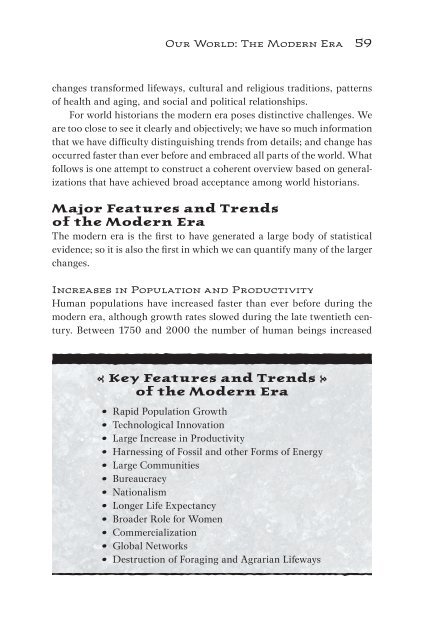This Fleeting World
This Fleeting World
This Fleeting World
You also want an ePaper? Increase the reach of your titles
YUMPU automatically turns print PDFs into web optimized ePapers that Google loves.
Our <strong>World</strong>: The Modern Era 59<br />
changes transformed lifeways, cultural and religious traditions, patterns<br />
of health and aging, and social and political relationships.<br />
For world historians the modern era poses distinctive challenges. We<br />
are too close to see it clearly and objectively; we have so much information<br />
that we have difficulty distinguishing trends from details; and change has<br />
occurred faster than ever before and embraced all parts of the world. What<br />
follows is one attempt to construct a coherent overview based on generalizations<br />
that have achieved broad acceptance among world historians.<br />
Major Features and Trends<br />
of the Modern Era<br />
The modern era is the first to have generated a large body of statistical<br />
evidence; so it is also the first in which we can quantify many of the larger<br />
changes.<br />
Increases in Population and Productivity<br />
Human populations have increased faster than ever before during the<br />
modern era, although growth rates slowed during the late twentieth century.<br />
Between 1750 and 2000 the number of human beings increased<br />
• Key Features and Trends •<br />
of the Modern Era<br />
• Rapid Population Growth<br />
• Technological Innovation<br />
• Large Increase in Productivity<br />
• Harnessing of Fossil and other Forms of Energy<br />
• Large Communities<br />
• Bureaucracy<br />
• Nationalism<br />
• Longer Life Expectancy<br />
• Broader Role for Women<br />
• Commercialization<br />
• Global Networks<br />
• Destruction of Foraging and Agrarian Lifeways


